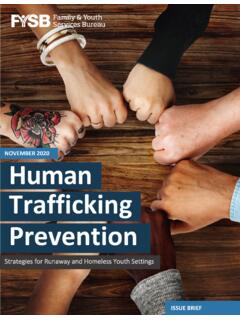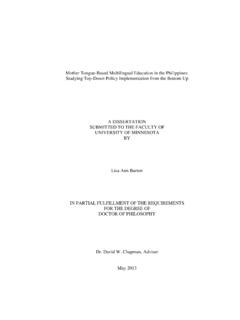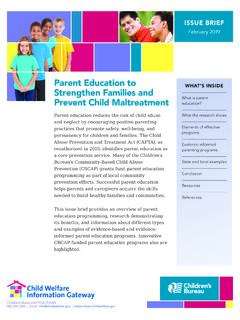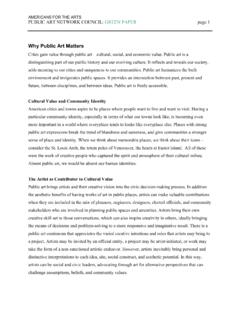Transcription of Identifying Barriers: Creating Solutions to Improve Family ...
1 161 School Community Journal, 2016, Vol. 26, No. 2 Available at Identifying Barriers: Creating Solutions to Improve Family EngagementTimberly L. Baker, Jillian Wise, Gwendolyn Kelley, and Russell J. SkibaAbstractReframing notions of parent involvement (being present in the school build-ing) to parent engagement (viewing multiple constructions of how parents are involved) is the purpose of this paper. The authors highlight the knowledge gained from data collected from a series of Family and staff focus groups re-garding parent and staff perceptions of barriers to Family involvement and from families suggestions as to what could be done differently to increase engage-ment. Using applied thematic analysis, five themes common to both families and staff are discussed: providing opportunities for involvement , improving communication, welcoming families into the building, making time, and mov-ing from involvement to engagement.
2 Findings show that, generally, parents and school staff agree on barriers to parent involvement but offer contrasting Solutions . While parent Solutions directly address the barriers identified and support parent engagement, staff frequently offered disconnected Solutions , reiterating parent involvement the necessity of parents being present in the building, rather than parent engagement multiple constructions of how par-ents are involved. Key Words: parent involvement , culturally responsive Family engagement, teachers, staff, parents, families, perceptions, barriers, Solutions , communica-tion, welcoming schools, focus group researchSCHOOL COMMUNITY JOURNAL162 IntroductionThe evidence is now beyond dispute. When schools work together with families to support learning, children tend to succeed not just in school, but throughout & Berla, 1994, p.
3 1A common complaint of educators is that parents are not involved enough in their children s schooling (Mapp, 2003; McKenna & Millen, 2013). Re-search has shown that the benefits of parent involvement include Creating better school community relationships (Lawson & Alameda-Lawson, 2012), contributing to greater gains in academic achievement (Henderson & Mapp, 2002; Lawson & Alameda-Lawson, 2012), and enhancing emotional devel-opment and behavior (Cai, Moyer, & Wang, 1997; Greenwood & Hickman, 1991). Parent involvement has been characterized as including demonstrable attendance at school events and reading to one s child (Jeynes, 2013, para. 1) as well as participating in prescribed activities that the school organizes (Jeynes, 2013). Parent involvement and parent engagement have been characterized differently by some authors, with each having specific par-ent behaviors associated with the construct.
4 Parent engagement, according to Ferlazzo (2011), is about engaging families to become partners with the school and listening to what parents think, dream, and worry about (p. 12). Ad-ditionally, Redding, Langdon, Meyer, and Sheley (2004) discuss qualities of parent engagement, including building a foundation of trust and respect, reaching out to parents beyond the school (p. 1). While there are distinct differences in characterization, there are similar benefits of increasing either. Parent involvement activities such as volunteering have been associated with a reduction in the number of students disciplined in school, fewer detentions, and a reduction in the number of students receiving multiple disciplinary con-sequences from one year to the next (Sheldon & Epstein, 2002).
5 Furthermore, increases in frequent and high quality interactions amongst teachers and par-ents yielded greater trust and respect, increased social capital for students, and provided more support for student success (Redding et al., 2004). The purpose of this article is to discuss the findings from focus groups with parents and school staff during which participants were asked about involvement at the school. It was found that questions about involvement developed into discus-sions about engagement. Thus, removing barriers to involvement may become a course of action to parent engagement. Family and staff focus groups were held in six schools in one Midwestern state involved in a discipline reform effort. As part of that reform and based on Identifying BARRIERS TO ENGAGEMENT163research and a framework developed by PBIS Indiana (2010), the participating schools were to address five areas of culturally responsive Family engagement: feedback systems to determine Family preferences for ongoing communica-tion (Fantuzzo & Tighe, 2000); specific efforts to involve families who generally have low participation rates (Harry, 2008; LaRocque, Kleiman, & Darling, 2011); Family and community involvement in making decisions about programs and services that meet the needs of all students (Hornby & Lafaele, 2011); staff involvement in finding ways to include the use of community re-sources (such as libraries or cultural and community centers.)
6 Sheldon & Epstein, 2002); and Family events that are held off-site in the community (Landsman & Lewis, 2006).This paper uses the results of this reform effort to address how schools can move from parent involvement (merely being present) to parent engagement (intentional efforts by the school to recognize and respond to parents' voic-es and to help school staff to better understand how to address barriers that parents have identified). This paper concludes with a discussion and recom-mendations about moving from involvement to and SchoolsThe term parent involvement has been used by teachers, school admin-istrators, and parents to include several characteristics of parent and school relationships (Hornby & Lafaele, 2011).
7 Parent involvement has been per-ceived as being present in the school building or school-centric involvement (Hornby & Lafaele, 2011; Jeynes, 2013; Lawson, 2003); this was based on the idea that schools and teachers should direct parental involvement . More-over, there was an emphasis on telling families how they can be involved in the school, rather than listening to parents and asking for their suggestions on improving students academic achievement and behavior (Ferlazzo, 2011). It is encouraging that recently, best practice in involving parents in schools has begun to expand beyond typical notions of parent involvement (Hornby & Lafaele, 2011; Mapp & Kuttner, 2013), which often require parents to par-ticipate in traditional and more limited ways, such as attending parent teacher conferences and helping with or attending events at the school (Jeynes, 2013; Mapp, 2003), to embrace a more expansive view of parent engagement mul-tiple constructions of how parents are involved (Redding et al.)
8 , 2004). These constructions include seeing parents, guardians, and other critical adults as equal partners in the success of students (Ferlazzo & Hammond, 2009). In addition to parent teacher conferences and homework, parents spend time SCHOOL COMMUNITY JOURNAL164with their children in meaningful ways that help them in school, for example, attending local community activities, traveling, being involved with a spiritu-al community, and being involved in extracurricular activities (Mapp, 2003). Home-based activities that parents typically engage in are important in how parents view their role in supporting their children and supporting the school (Epstein, 1995; Okagaki & Frensch, 1998; Tran, 2014).A primary factor in children s educational successes is parent interest and support (Berger, 1995), and studies of parent involvement have shown measur-able gains in academic achievement as parents become more engaged (Amatea & Dolan, 2009; Henderson, 1981, 1987; Tran, 2014).
9 Engaged parents have greater educational aspirations for their children (Greenwood & Hickman, 1991; Hornby & Lafaele, 2011), improved communication with their child (Chavkin, 1989; Wilder, 2014), and more positive attitudes toward their child s teacher (Pe a, 2000; Tran, 2014). They often feel more confident about their abilities to help their children, gain a better understanding of both formal and informal rules of the school, and develop an appreciation and a greater knowl-edge about the importance of their role in their child s education (Amatea & Dolan, 2009; Henderson, Mapp, Johnson, & Davies, 2006; Johnson, Pugach, & Hawkins, 2004). Additionally, schools are becoming more aware of the ben-efits to the quality of school life when schools and families form collaborative relationships (Smith, Wohlstetter, Kuzin, & De Pedro, 2011).
10 School climate and academic learning improved in some schools when Family engagement in-creased (Muscott et al., 2008). Decreases in disciplinary incidences have been documented as a result of Family school collaborations, which are also associ-ated with an overall increase in student safety (Sheldon & Epstein, 2002). As relationships between schools and families Improve , teachers gain a more posi-tive view of their students families and feel more supported in their work with students (Amatea & Dolan, 2009; Hoover-Dempsey et al., 2005; Sheldon & Epstein, 2002). Schools that implement consistent and comprehensive parent programs over long periods of time are more effective in engaging parents and outperform schools with little or no parent involvement (Pe a, 2000). While parents and guardians are increasingly expressing the desire to be-come more involved in their children s education (Mapp, 2003; Warren, Hong, Rubin, & Uy, 2009), a number of barriers hinder parents ability to be involved, particularly in the more traditional and visible forms of Family in-volvement such as volunteering at school events and attending parent teacher conferences each grading period (Hornby & Lafaele, 2011).














